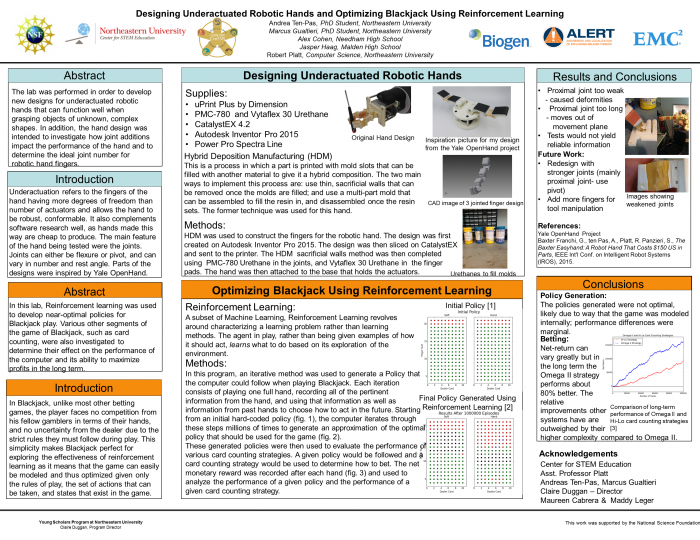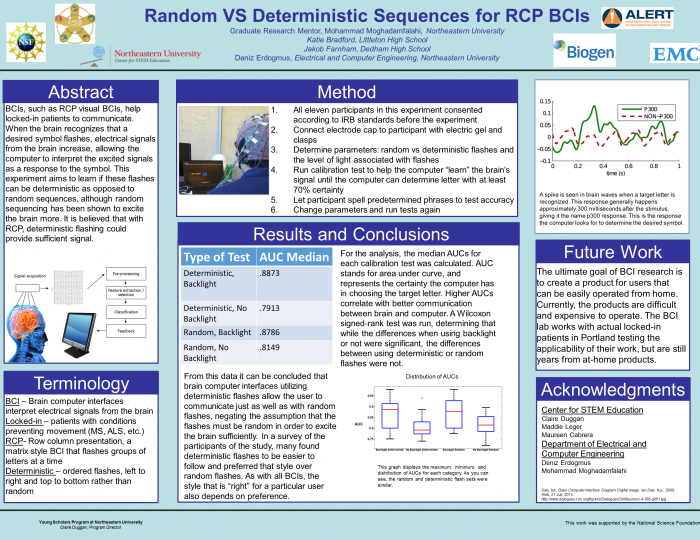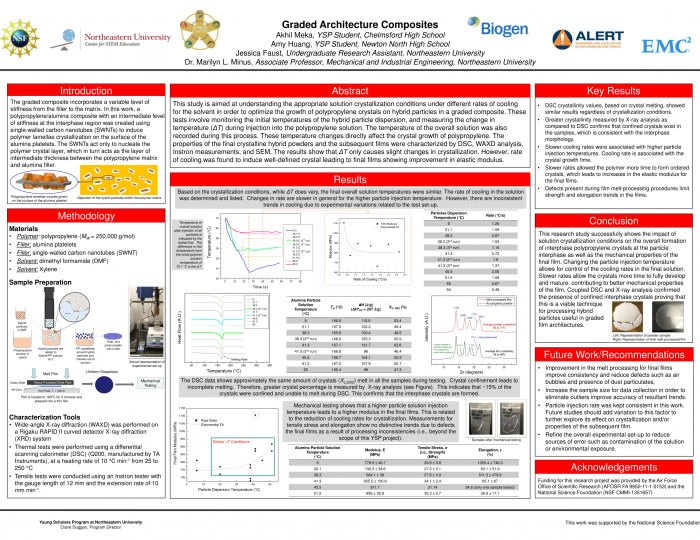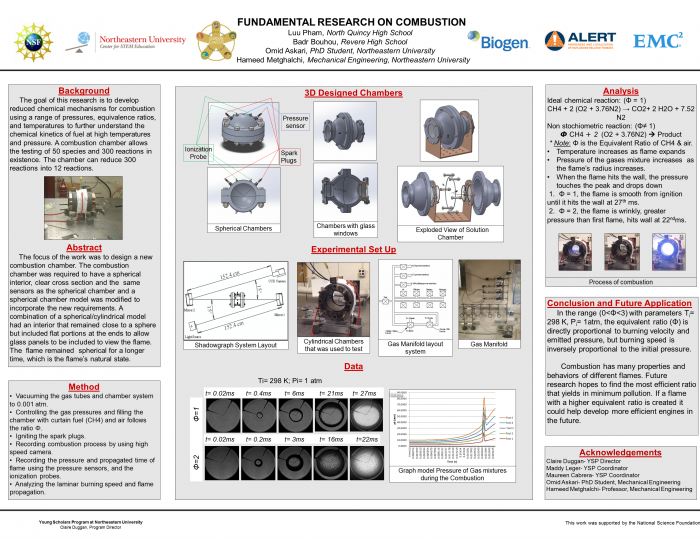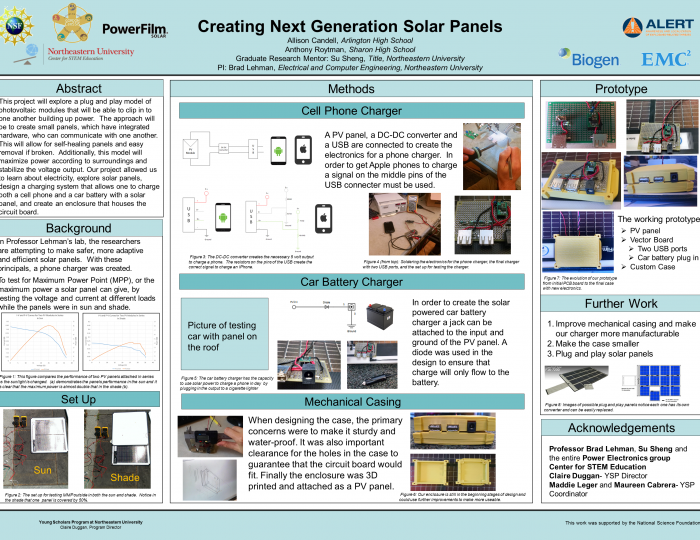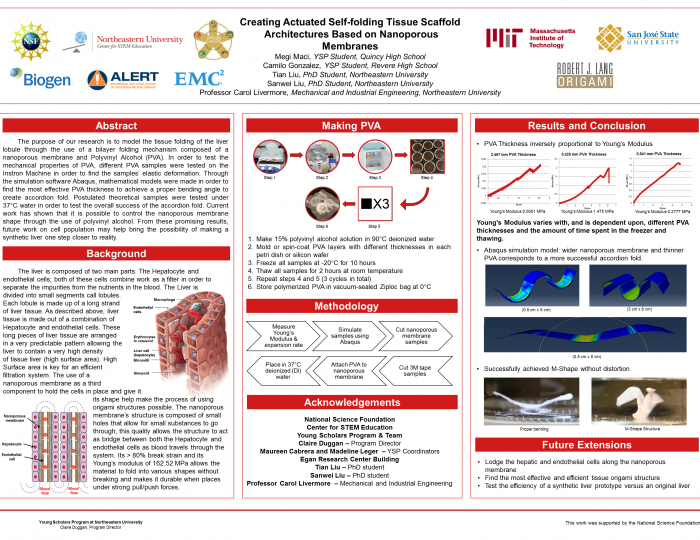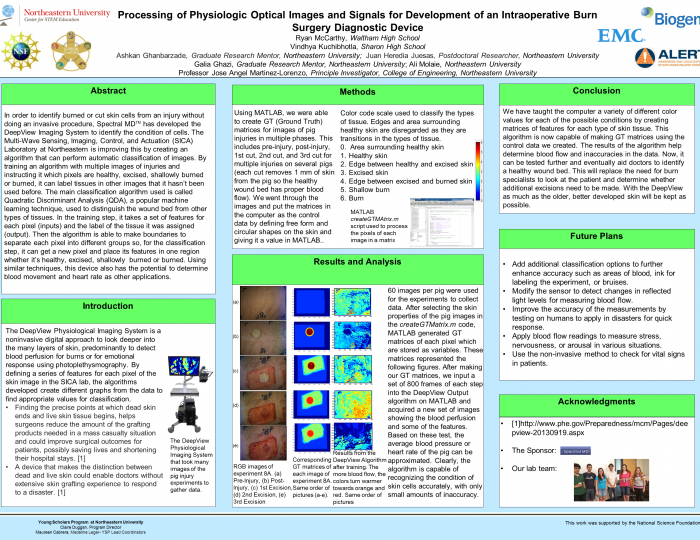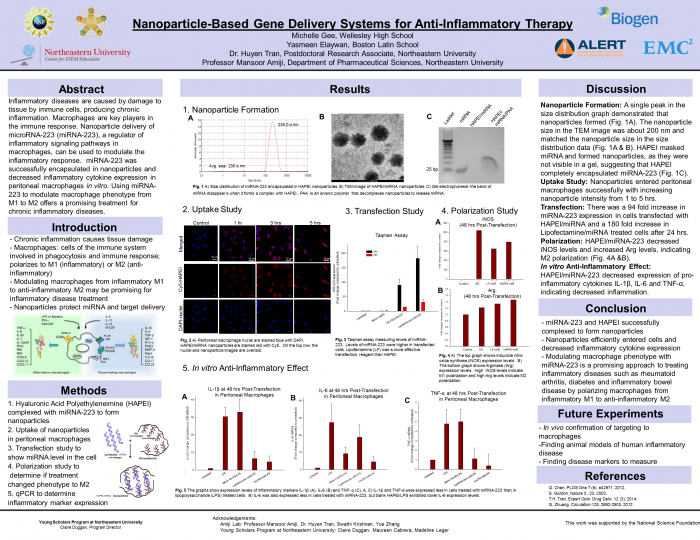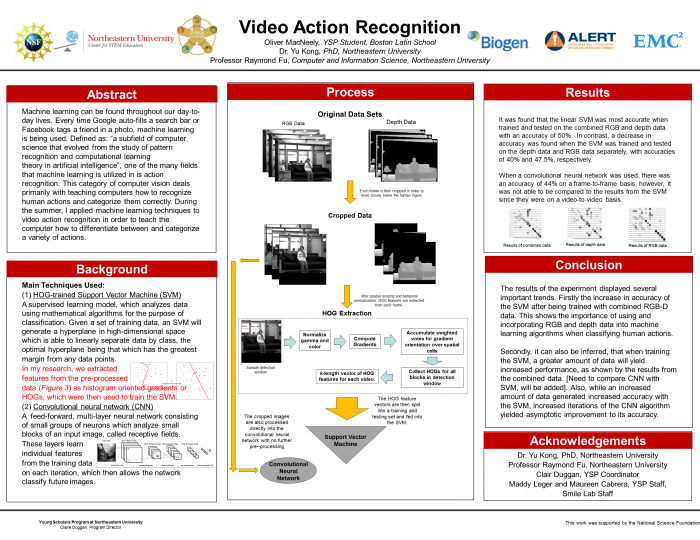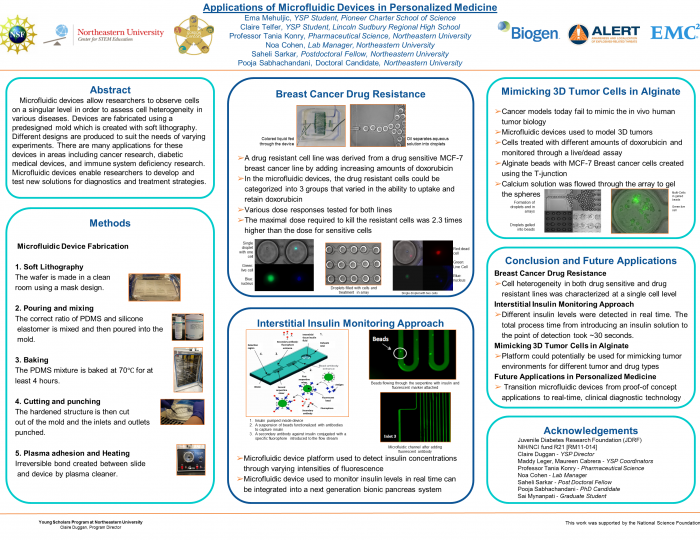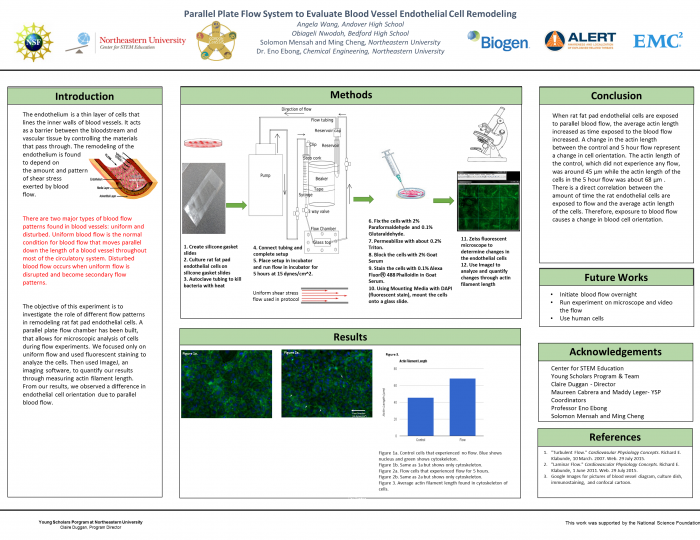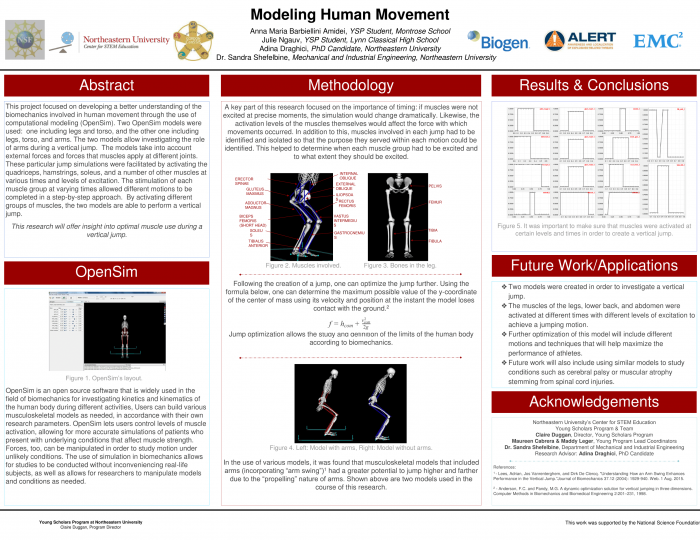YSP Alumni
Alumni Directory
2015 YSP Program Coordinators: Maureen Cabrera and Maddy Leger
Participating Labs
| Faculty | YSP Students | Title | Abstract |
|---|---|---|---|
| Faculty: Amiji, Mansoor | Yasmeen Elaywan, Michelle Gee | Nanoparticle-Based Gene Delivery Systems for Anti-inflammatory Therapy | The purpose of this study will be modulating macrophage functional polarity by nanoparticle-based gene delivery systems for anti-inflammatory effect. Macrophages are phagocytic cells with important functions in orchestrating an immune response to infection/inflammation. Macrophages alternate between two distinct phenotypes pro-inflammatory (M1) and anti-inflammatory (M2) macrophages. Modulating their phenotypes from M1 to M2 state would provide a potential therapeutic mechanism against chronic inflammatory diseases. The YSP students will try to prepare and characterize nanoparticle-based gene delivery systems, and perform in vitro macrophage polarization study. |
| Faculty: Ebong, Eno | Angela Wang, Oblageli Nwodoh | Blood Vessel Cell Communication and "Sugar Coating" | Atherosclerosis, a blood vessel disease defined by arterial hardening due to tissue remodeling and plaque buildup, occurs at artery branches where blood flow is unstable. The Ebong Group is conducting basic research to study the impact of blood flow-derived forces on the integrity of blood vessel endothelial cells, which make up the protective skin of the inner blood vessel wall and are the first line of defense against atherosclerosis. Since atherosclerosis is a precursor to heart attack, stroke, aneurysm, peripheral vascular disease, and retinal vascular disease, this research is critical for solving serious and costly societal health problems. |
| Faculty: Erdogmus, Deniz | Katie Bradford, Jakob Farnham | Experimental Comparison of Two Brain Interfaced Typing Paradigms | CSL developed a unified software framework in Matlab, which allows for individuals with locked-in syndrome and other severe speech and motor disabilities to use their brain signals to type. This framework currently has RSVP Keyboard and Matrix Speller paradigms for alphabet presentation and brain stimulation. The summer interns will learn how to use the existing software and EEG hardware to run experiments, collect data from healthy participants, and perform statistical tests on acquired data to evaluate three forms of visual stimulus presentation in this brain interfaced typing framework. The work includes experiment design, experimental data collection, and statistical data analysis. An understanding of brain computer interface systems will be developed through active engagement in the BCI team at CSL. |
| Faculty: Fu, Raymond | Oliver MacNeely | Social Media Analytics | SMILE lab focuses on the frontier research of applied machine learning, social media analytics, human-computer interaction, and high-level image and video understanding. Our research is driven by the explosion of diverse multimedia from the Internet, personal or publicly available photos and videos. We start by treating fundamental theory from learning algorithm as the soul of machine intelligence and arm it with visual perception. What follows is a synergetic media learning system that not only actively collects massive visual information from the environment, but also processes and responds human interactively with precise analysis and possible suggestions. Depending on the level of math and software knowledge, participants can engage in our projects with an appropriate contribution, or they can choose to develop their own project if they want. We will provide sufficient resources to facilitate such explorations. |
| Faculty: Jung, Yung Joon | James Zhou, Gary Hu | Building Nanotube Fiber Electrical Fusion System | This research focuses on a novel carbon nanostructure engineering process called nanotube fusion. This highly controllable method controls input voltages across the network to create covalently bonded molecular junctions (cross-links) between CNTs, transforming them into larger diameter single-walled CNTs, multi-walled CNTs, or multi-layered graphene nanoribbons with tremendous property improvement. The overall research objective of this project is to create high-performing fibers for applications in aerospace, high power density energy storage, lightweight cabling/wiring, structural health monitoring, and more. |
| Faculty: Konry, Tali | Ema Mehuljic, Claire Telfer | Bio-MEMS Approaches to Advance Point of Care Diagnostics, Cell Culture and Drug Screening, and Delivery Methods | The lab is focused on developing novel Bio-MEMS approaches to advance point of care diagnostics, cell culture and drug screening and delivery methods. This lab has developed the Lab-on-a-Chip (LOC) devices that integrate several laboratory functions such as real time monitoring of target clinically relevant analyte, proteomics, genomics, cell-cell interactions as well as cell secretion and surface monitoring of single cells on a micro-chip. The advantages of the microfluidic based LOC developed by the lab include, the pico and nano-liter volumes, elimination of cross-contamination, the fast and efficient mixing of reagents and gases and the ability to manipulate and analyze cells at a very high-throughput. |
| Faculty: Lehman, Brad | Anthony Roytman, Allison Candell | Building Next Generation Solar Panels | This project will build new types of solar panels. The approach will be to create small panels that have electronics integrated in them. The small panels will be able to clip on to each other in a plug and play fashion to build up power. The panels will communicate with each other and ultimately be able to: 1) self-heal when there are faults in the system, 2)optimize energy extraction by adopting their operation according to light intensity, and 3) create a stable output voltage for battery chargers. The YSP student will help design various aspects of the solar photovoltaic system, including mechanical layout, fuses, electric circuits, simulation models in CAD and/or MATLAB. Extensive experimentation in solar energy will occur both outside as well in the indoor lab. |
| Faculty: Livermore, Carol | Camilo Gonzalez, Megi Maci | Creating Actuated Self-folding Tissue Scaffold Architectures Based on Nanoporous Membranes | Tissue engineering can save lives by supplementing the supply of organ transplants and by enabling the screening of new medical therapies before any human testing takes place. However, it is also incredibly complex. Tissues cannot survive without an adequate supply of nutrients and oxygen, or without removal of metabolic byproducts. Vascular networks provide these functions in most human tissues, but it has proven difficult to create effective vasculature in engineered tissues. A seemingly simple solution would be to seed cells onto a scaffold and let the developing tissue form its own vasculature, but research has shown that the resulting vascular networks are not sufficiently well-organized to supply the tissue. Despite the progress represented by this research, available techniques for tissue engineering are still limited by the need for serial processing (which limits throughput), an inability to produce truly 3D vascular networks, or both. The purpose of our research is to create tissue with excellent structural control and high throughput through a scalable process. In this process, the different types of cells that make up the tissue are first assembled onto a two-dimensional polymer scaffold sheet using a process that precisely controls the cells’ positions on the sheet. The sheet is then origami folded into three dimensions so that the cells align to create the proper tissue features. In this way, the ability to organize cells in two dimensions will enable the creation of fully three-dimensional tissue. |
| Faculty: Martinez, Jose | Ryan MacCarthy, Vindhya Kuchibhotla | Standoff Detection of Security Threats Using Millimeter Wave Radar at Millimeter Wave Frequencies. | We are developing a new radar system concept, capable of detecting explosive related threats at standoff distances. The system consists of a two dimensional aperture of randomly distributed transmitting/receiving antenna elements and a set of Passive Reflecting Surfaces (PRS) positioned in the vicinity of the target. A 3D imaging algorithm, based on novel compressive sensing techniques, is used in this work. |
| Faculty: Metghalchi, Hameed | Luu Pham, Badr Bouhou | Fundamental Research on Combustion | Professor Metghalchi's research includes fundamental combustion studies such as flame propagation speed, flame stability, auto-ignition and development of chemical kinetics model to save computational time for combustion modeling. Experiments are performed in cylindrical and spherical vessels. Flame structure and flame stability analyses are done in the cylindrical vessel using a high speed camera. Flame speeds have been measured using both vessels. Different fuels such as bio-fuel and other conventional fuels are used in these studies. Burning speeds of fuel/air/diluent mixtures over a wide range of pressures, temperatures and equivalence ratios are measured. |
| Faculty: Minus, Marilyn | Amy Huang, Akhil Meka | Graded Architecture Composites | This project will make use of colloidal assembly techniques to create hybrid particles with multi-scale morphology to reinforce polymer-based discontinous composites. This assembly process will enable formation of materials with graded architectures. |
| Faculty: Platt, Robert | Alex Cohen, Jasper Haag | Human Tracking Using Vision and Sonar | The goal for this project is for the student to develop a system for human tracking using vision and/or sonar. Human tracking is important in a robotics context because robots typically need to interact with people. In this case, the robot will use vision algorithms to track the motion of the person and potentially move the robot head in order to keep the person in the center of view. Sonar may be used as a way of coarsely estimating the human position. |
| Faculty: Rappaport, Carey | Shiva Nathan, Lingrui Zhong | Advanced Imaging Technology Radar Security Sensing | The Advanced Imaging Technology project began Fall, 2010 with the goal of developing an improved multi-modality portal-based passenger screening system. Millimeter-wave, x-ray backscatter, infrared sensing, and Terahertz sensing are being considered. Initial concentration in mm-wave imaging makes use of optimal antenna placement, model-based inversion, superior frequency specification, and custom designed radar hardware. A specially-built hardware platform has been designed and built. Consisting of mechanical and electrical subcomponents it will facilitate reconfigurable sensor placement in order to develop a multi-static imaging radar system. |
| Faculty: Shefelbine, Sandra | Anna Maria Barbiellini, Julie Nguav | Modeling Human Movement | Human movement consists of a complex system of joints and linkages working together to produce coordinated movements. Muscles create torques around the joints to produce movements. In disease diagnosis and monitoring, rehabilitation, and sports performance, it is helpful to know which muscles are active during a particular movement. To do this, we use musculoskeletal computer models of the bones, joints and muscles. Because there is more than one combination of muscle activities that can create a motion, optimization routines are used to determine the most likely activation patterns. In this project, we will use the open source OpenSimmTK modeling software to create models of walking and exercise and examine the effects of muscle weakness on joint loads. Such models can be used to inform physical therapy regimes, determine rehab progression, or as biometric feedback on sports performance. |

